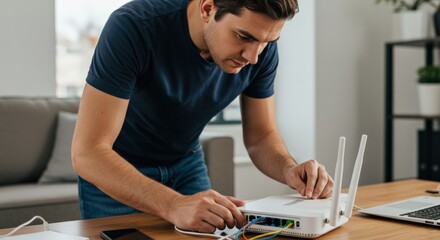In the world of home and business networking, 192168.15.1/instalador a router or modem is the central hub that connects devices to the internet. To set up or configure such a device, users often need to access its administrative interface via a private IP address. One common entry point for certain models, particularly from specific ISPs and manufacturers, is 192168.15.1/instalador. This URL represents a gateway to the router’s installer page, designed to streamline the initial configuration process.
If you’ve purchased a new router or modem—or reset one to factory defaults—this address might be your first step in customizing your internet connection. In this guide, we’ll break down every detail about what this address means, how to use it effectively, how to troubleshoot issues, and how to optimize your network’s performance and security.
Understanding 192.168.15.1 and Its Purpose
Private IP Addresses
The number 192.168.15.1 is part of a reserved range of IP addresses used in private networks. Unlike public IP addresses, which are unique on the global internet, private IP addresses are used internally within homes, offices, and other local networks. This keeps them hidden from direct outside access, reducing certain security risks.
Class C Addressing
192.168.15.1 falls within the Class C range of IPv4 addresses. Class C networks are often used for small-to-medium-sized networks, making them perfect for household and small business router setups. By default, this address often serves as the gateway—the path through which all devices in the network communicate with the outside internet.
Role in Router Configuration
When you enter 192.168.15.1 in your browser, you’re essentially contacting the router’s internal web server. The router responds by displaying its administration interface, where you can configure Wi-Fi settings, manage security options, and monitor your network.
What Is the /instalador Page?
The /instalador part is a directory or path appended to the IP address. In this case, “instalador” is Portuguese for “installer,” indicating that this page is likely part of an installation wizard used in initial router setup.
Purpose of the Installer
The installer page is designed to simplify configuration for non-technical users. Instead of navigating through complex menus, the page walks you through:
-
Setting the internet connection type.
-
Choosing Wi-Fi names and passwords.
-
Configuring basic security.
-
Activating the connection with your ISP.
Routers That Use This Setup
Several brands and ISPs, particularly in Latin America, Brazil, and Portugal, provide firmware that includes a /instalador path. Commonly, routers provided by Vivo/Telefônica, Oi, and other service providers may include this feature.

Preparing to Access the Setup Page
Before logging into 192.168.15.1/instalador, you should ensure the following:
Check Your Network Connection
-
Connect your computer or mobile device directly to the router via Ethernet cable or Wi-Fi.
-
Avoid using mobile data; it won’t allow you to access the local router page.
Locate Default Login Credentials
-
Many routers have a sticker on the underside or back that lists the default username and password.
-
Common defaults include:
-
Username:
admin -
Password:
adminor1234
-
-
Some ISPs use unique credentials for each device.
Disable VPNs or Proxies
Using a VPN or proxy can route your connection outside your local network, preventing access to the IP.
Step-by-Step Guide to Access 192168.15.1/instalador
Here’s how to reach the installer page safely and efficiently:
-
Open Your Browser
Launch Chrome, Firefox, Edge, Safari, or another web browser. -
Enter the Address
Type:and press Enter.
-
Handle Security Warnings (If Any)
Sometimes, browsers warn about security certificates on local pages. It’s safe to proceed if you’re connected to your own router. -
Log In
Use the default or custom credentials. -
Follow the Setup Wizard
The/instaladorpage will guide you through essential settings.
First-Time Configuration
When you reach the installation page, the most important task is to configure your internet and Wi-Fi properly.
Internet Connection Type
Your ISP may require a specific connection type:
-
PPPoE: Requires a username and password from your provider.
-
DHCP (Dynamic IP): Most common; settings are assigned automatically.
-
Static IP: Requires you to enter IP, subnet, and gateway details manually.
Wi-Fi Network Name (SSID)
Choose a unique and recognizable name, but avoid using personal information.
Wi-Fi Security
Use WPA2 or WPA3 encryption with a strong password.
Security Best Practices
A properly configured router is not just about speed—it’s also about protecting your data.
-
Change Admin Password: Default credentials are a major security risk.
-
Enable WPA3 or WPA2: This ensures your wireless network is encrypted.
-
Disable WPS: WPS can be exploited by attackers.
-
Use a Guest Network: Isolate visitors from your main devices.
Troubleshooting Access Issues
Sometimes, 192.168.15.1/instalador won’t load. Here’s what to check:
Confirm the Router’s IP
Open Command Prompt (Windows) or Terminal (Mac/Linux) and type:
or
Look for “Default Gateway.”
Restart Your Router
A simple reboot can fix temporary glitches.
Factory Reset
If you’ve forgotten credentials, hold down the reset button for 10–30 seconds to restore defaults.
Advanced Settings for Power Users
Once you’re familiar with the basics, explore advanced options:
-
Port Forwarding: For hosting game servers or remote access.
-
QoS (Quality of Service): Prioritize bandwidth for important devices.
-
Firmware Updates: Improve performance and security.
-
Parental Controls: Limit access to inappropriate content.
Common Mistakes to Avoid
-
Leaving Default Passwords: A major vulnerability.
-
Misconfiguring IP Ranges: Can cause network conflicts.
-
Skipping Firmware Updates: Leaves your router exposed to known vulnerabilities.

When to Contact Your ISP or Manufacturer
If all else fails:
-
Your router might be faulty.
-
The ISP may have disabled user access to certain settings.
-
Firmware could be outdated or incompatible.
Conclusion
The address 192168.15.1/instalador is a crucial gateway to setting up and securing your home or office network. By understanding what it is, how to access it, and how to optimize the settings, you can ensure a fast, stable, and secure internet connection. Whether you’re a first-time user or a tech enthusiast, mastering your router’s installer page is the foundation for reliable connectivity.
FAQs
Q1: What is 192168.15.1/instalador?
A1: It’s a private IP address with a specific path (“/instalador”) that leads to a router’s installation wizard. This page allows you to set up internet connection types, configure Wi-Fi, and apply security settings.
Q2: How do I log in to 192168.15.1/instalador?
A2: Connect to your router via Wi-Fi or Ethernet, open a web browser, type http://192.168.15.1/instalador into the address bar, press Enter, and enter your login credentials (often printed on your router).
Q3: Why can’t I access 192168.15.1/instalador?
A3: Possible reasons include being connected to the wrong network, using the wrong IP address, having a VPN active, or your router using a different gateway. Check your “Default Gateway” in network settings to confirm.
Q4: What are the default login credentials for 192168.15.1/instalador?
A4: Many routers use admin for both username and password, but ISPs may assign unique credentials. Always check the label on your router or the documentation provided by your service provider.
Q5: Is it safe to use 192168.15.1/instalador?
A5: Yes—if you’re connected to your own network. It’s a local address, not accessible from the internet. However, always change default passwords and enable encryption to prevent unauthorized access.


